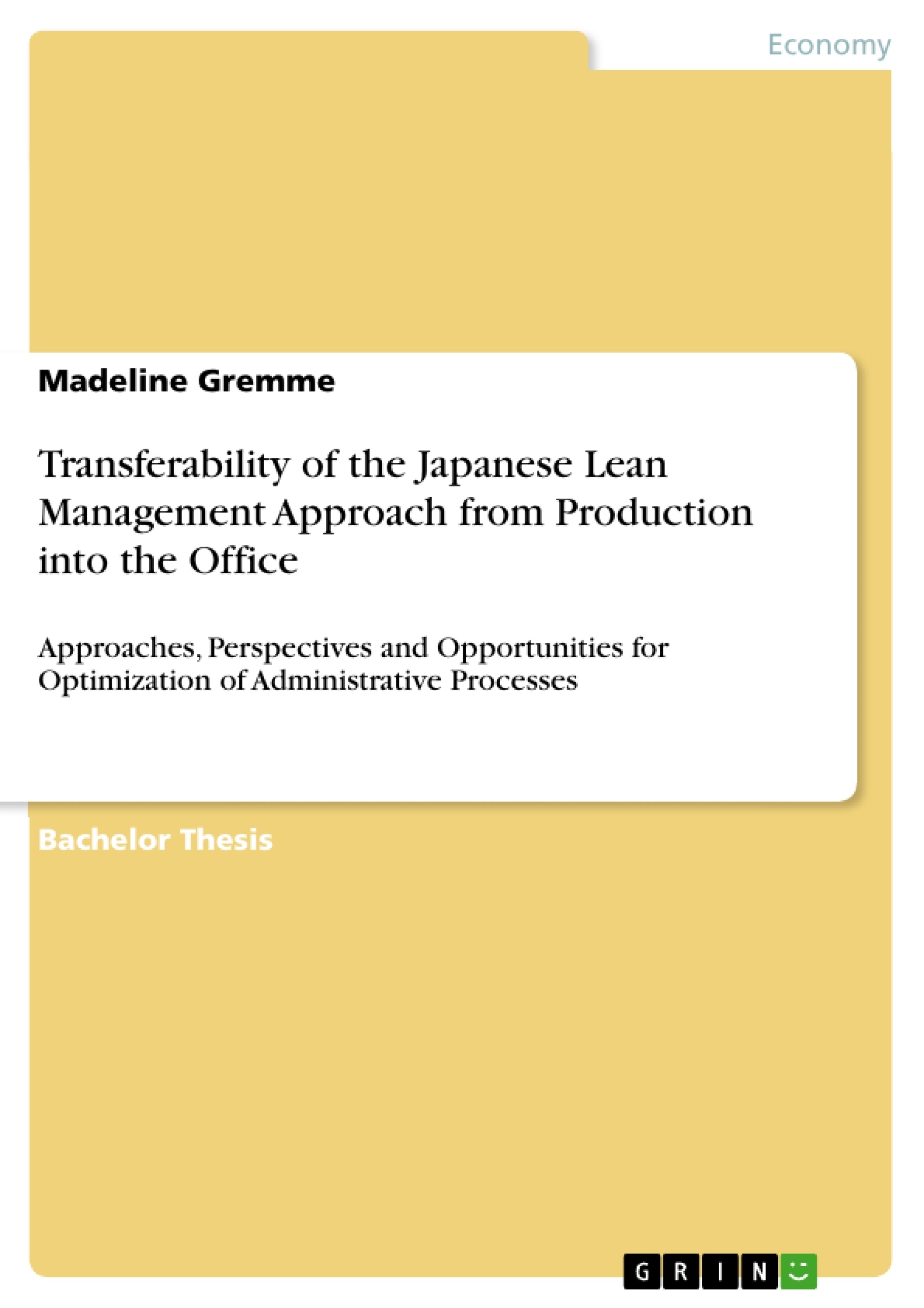
Transferability of the Japanese Lean Management Approach from Production into the Office
Bachelorarbeit, 2015
102 Seiten, Note: 1,3
Leseprobe
Inhaltsverzeichnis (Table of Contents)
- Introduction
- Problem statement
- Objective
- Structure of the Thesis
- Development of the Lean Philosophy
- Top-Down or Bottom-Up Management Approach
- History and Core Idea
- Definition of the term "Lean Management"
- Usage of the term “Lean”
- From TPS to Lean Administration
- Process Optimization with Lean Administration
- In Search of Wastefulness - the 3 MU's
- MUDA - The 7 Types of Waste
- MURA - Wasteful imbalance or deviation
- MURI - Wasteful overload or overburden
- Lean Principles
- Methods
- Value Stream Mapping
- The Kanban Board
- CIP - The Continuous Improvement Process
- PDCA Cycle
- 6W Questioning Technique
- 5S Method
- Ishikawa Diagrams
- Performance Indication Systems
- Employee involvement
- In Search of Wastefulness - the 3 MU's
- Critics and barriers for implementation
- Lack of contingency
- Human aspects
- Scope and lack of strategic perspective
- Coping with Variability
- Further barriers in Administration
- Practical example of Lean Administration implementation
- Methodical approach to data collection via interview
- Evaluation method of the interviews
- Key results of the experts interviews
- Résumé
- Summary of key messages
- Target of the Thesis
- Outlook
Zielsetzung und Themenschwerpunkte (Objectives and Key Themes)
This thesis aims to investigate the transferability of the Japanese Lean Management approach from production to office administration. It explores the approaches, perspectives, and opportunities for optimizing administrative processes through the adoption of Lean principles. The research focuses on identifying and analyzing the challenges and potential benefits of implementing Lean in an office setting.
- Transferability of Lean Management from production to office environments
- Identification of waste and inefficiencies in administrative processes
- Application of Lean principles and tools in an administrative context
- Analysis of critical factors and barriers to successful implementation
- Evaluation of the practical application of Lean in a specific case study
Zusammenfassung der Kapitel (Chapter Summaries)
Introduction: This chapter introduces the research topic, outlining the problem statement and the objectives of the thesis. It highlights the gap in research concerning the application of Lean Management in administrative settings and lays the groundwork for the subsequent chapters by explaining the structure and methodology of the study.
Development of the Lean Philosophy: This chapter traces the historical development of Lean Management, from its origins in the Toyota Production System (TPS) to its broader applications. It explores different management approaches (top-down vs. bottom-up) and provides a thorough definition of Lean Management, differentiating its use and application across various contexts. The chapter carefully explains the evolution of Lean thinking and its expansion beyond manufacturing, laying the foundation for understanding its potential in administrative contexts.
Process Optimization with Lean Administration: This chapter delves into the core concepts of Lean Administration, focusing on identifying and eliminating waste (muda, mura, muri). It details the seven types of Muda, providing specific examples of their manifestation in office settings. Further, the chapter introduces key Lean principles and various methods for implementation, including Value Stream Mapping, Kanban, the PDCA cycle, and the 5S methodology. These methods are explored in detail, linking them to the overarching goal of waste reduction and process optimization.
Critics and barriers for implementation: This chapter critically examines the challenges and obstacles encountered when implementing Lean Management in administrative contexts. It addresses issues such as lack of contingency planning, human resource aspects (resistance to change, lack of employee engagement), strategic misalignment, and difficulties in managing variability. The chapter analyzes these barriers in detail and explores potential strategies for mitigating their negative impact on successful Lean implementation.
Practical example of Lean Administration implementation: This chapter presents a case study illustrating the practical application of Lean in an administrative setting. It describes the methodology used for data collection (interviews), the analysis techniques employed, and presents key findings. The chapter showcases the successful implementation (or lack thereof) of Lean techniques and analyzes the results, tying them back to the themes explored in previous chapters.
Schlüsselwörter (Keywords)
Lean Management, Lean Administration, process optimization, waste reduction, Kaizen, Kanban, Value Stream Mapping, PDCA cycle, office efficiency, administrative processes, Toyota Production System (TPS), Muda, Mura, Muri, implementation challenges, case study.
Frequently Asked Questions: A Comprehensive Language Preview on Lean Administration
What is the main topic of this thesis?
This thesis investigates the application of Lean Management principles, originally developed for manufacturing, to office administration. It explores how Lean methodologies can optimize administrative processes, improve efficiency, and reduce waste.
What are the key objectives of the research?
The primary objective is to determine the feasibility and effectiveness of transferring Lean Management from production environments to office settings. The research also aims to identify common types of waste in administrative processes, apply relevant Lean tools, analyze implementation challenges, and evaluate a practical case study.
What is Lean Management and how does it relate to this research?
Lean Management is a systematic approach to optimizing processes by identifying and eliminating waste. This thesis examines the evolution of Lean Management from its roots in the Toyota Production System (TPS) and explores its adaptation for administrative contexts. It focuses on the core principles of Lean, including the elimination of Muda (waste), Mura (inconsistency), and Muri (overburden).
What Lean tools and methods are discussed in this thesis?
The thesis covers a range of Lean tools, including Value Stream Mapping, Kanban boards, the Continuous Improvement Process (CIP) with the PDCA cycle, the 6W questioning technique, the 5S method, and Ishikawa diagrams. These tools are analyzed in the context of their application to administrative processes.
What are some of the challenges in implementing Lean in an administrative setting?
The thesis identifies several critical barriers to successful Lean implementation in office environments. These include a lack of contingency planning, resistance to change from employees, insufficient strategic alignment, difficulties in managing variability, and a general lack of understanding of Lean's applicability within an administrative context.
What methodology is used in the thesis to analyze the effectiveness of Lean in administration?
The research utilizes a mixed-methods approach. A literature review establishes a theoretical foundation for the study. Furthermore, a practical case study, incorporating data collection through interviews and subsequent analysis of the interview results, provides empirical evidence to support the thesis' findings.
What are the key findings or results of the case study?
The case study section presents the results of applying Lean principles to a specific administrative setting. This section details the data collection methods (interviews), evaluation techniques, and key findings regarding the successful application (or otherwise) of Lean techniques in the examined context. This demonstrates the practical implications of the research findings.
What are the overall conclusions and future outlook of the research?
The concluding chapter summarizes the key findings, reiterates the thesis' objectives, and provides an outlook for future research. It highlights the potential benefits of Lean Administration while also acknowledging the persistent challenges and requiring further investigation of specific areas for improvement.
What are the key words associated with this research?
Key words include: Lean Management, Lean Administration, process optimization, waste reduction, Kaizen, Kanban, Value Stream Mapping, PDCA cycle, office efficiency, administrative processes, Toyota Production System (TPS), Muda, Mura, Muri, implementation challenges, case study.
Details
- Titel
- Transferability of the Japanese Lean Management Approach from Production into the Office
- Untertitel
- Approaches, Perspectives and Opportunities for Optimization of Administrative Processes
- Hochschule
- FOM Hochschule für Oekonomie & Management gemeinnützige GmbH, Dortmund früher Fachhochschule
- Veranstaltung
- International Management
- Note
- 1,3
- Autor
- Madeline Gremme (Autor:in)
- Erscheinungsjahr
- 2015
- Seiten
- 102
- Katalognummer
- V299411
- ISBN (eBook)
- 9783656960096
- ISBN (Buch)
- 9783656960102
- Dateigröße
- 1597 KB
- Sprache
- Englisch
- Anmerkungen
- Formal eine sehr saubere Arbeit ohne größere Fehler. Note 1,3 Methodisch sehr gut, die Auswahl von Experteninterviews als empirische Methodik wird begründet und reflektiert. Note 1,3 Inhaltlich eine sehr gute Arbeit. Die Autorin schafft es, die Problemstellung stringent zu diskutieren und dabei ansprechend und abwägend zu argumentieren. Sprachlich verwendet sich einen wissenschaftlich neutralen und angemessenen Duktus. Note 1,3 Die Arbeit wird im Ergebnis beurteilt mit der Note sehr gut (1,3).
- Schlagworte
- Lean Lean Management Lean Office Prozessoptimierung Top-Down Management Approach Bottom up Management Approach
- Produktsicherheit
- GRIN Publishing GmbH
- Preis (Ebook)
- US$ 38,99
- Preis (Book)
- US$ 49,99
- Arbeit zitieren
- Madeline Gremme (Autor:in), 2015, Transferability of the Japanese Lean Management Approach from Production into the Office, München, Page::Imprint:: GRINVerlagOHG, https://www.diplomarbeiten24.de/document/299411
- Autor werden
- Ihre Optionen
- Vertriebskanäle
- Premium Services
- Autorenprofil
- Textarten und Formate
- Services für Verlage, Hochschulen, Unternehmen

- © GRIN Publishing GmbH.
- Alle Inhalte urheberrechtlich geschützt. Kopieren und verbreiten untersagt.
- info@grin.com
- AGB
- Open Publishing
Der GRIN Verlag hat sich seit 1998 auf die Veröffentlichung akademischer eBooks und Bücher spezialisiert. Der GRIN Verlag steht damit als erstes Unternehmen für User Generated Quality Content. Die Verlagsseiten GRIN.com, Hausarbeiten.de und Diplomarbeiten24 bieten für Hochschullehrer, Absolventen und Studenten die ideale Plattform, wissenschaftliche Texte wie Hausarbeiten, Referate, Bachelorarbeiten, Masterarbeiten, Diplomarbeiten, Dissertationen und wissenschaftliche Aufsätze einem breiten Publikum zu präsentieren.
Kostenfreie Veröffentlichung: Hausarbeit, Bachelorarbeit, Diplomarbeit, Dissertation, Masterarbeit, Interpretation oder Referat jetzt veröffentlichen!
- GRIN Verlag GmbH
-
- Nymphenburger Str. 86
- 80636
- Munich, Deutschland
- +49 89-550559-0
- +49 89-550559-10
- info@grin.com
-










Kommentare